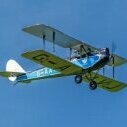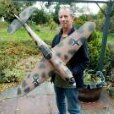Leaderboard
Popular Content
Showing content with the highest reputation on 05/01/23 in all areas
-
11 points
-
Hanky Planky in flight! Due to its small size and wide speed range, it is not easy to photograph.3 points
-
Before I electrified it, my Limbo Dancer flew well with a ST34 and a 13x4 prop. I chose a fine pitch prop because funflies need acceleration at very low airspeed. I electrified it with a 4S LiPo and used the same size prop. Can't recall the motor I used (the model no longer exists) but the main snag was the need to remove the banded on wings to replace the battery. I mounted the esc under the fuselage between the undercarriage legs which allowed me to connect the battery after the wings were re-fitted. For rough approximations when choosing an electric power train I usually assume the cell voltage to be 4v - so 12v for a 3S and 16v for a 4S3 points
-
back in the day, we used to boil nylon propellers to try and make them less brittle.....3 points
-
Hi Nigel For good funfly/3D flying you should be looking at a 1.75 to 2.00 to 1 power to weight ratio So if your model weighs for example 500g you should be looking for 875-1000g of static thrust We no longer refere to watts and watts per pound as from experience we find this not a good indication of performance. If you used our products then the nearest test results we have are as follows We haven't tested it with a 13x4, the top speed of a 13x4 may be too low at around 36MPH 13x5 JXF High performance Wooden prop 14.8V under load 33.2A at 14.8V 8955RPM Measured static thrust 2987g/6.59lbs Estimated top speed 42MPH To get the best flight performance you need the lightest possible setup. Funflys generally have short noses so you need to get the motor as far forward as possible, then work out how much weight you need to get the model to balance. based upon that weight choose a battery near that weight. We recommend the smallest battery for a funfly/3d model to be around 15 x max Amps In this case 33.2/15 = 2.21 so Look at the weight of a 4S 2200mAh LiPo Cheap LiPo's don't last and they don't perform even if the "specification" is the same. Try one of our 60C LiPo's you won't be dissapoinrted. https://www.4-max.co.uk/lipos.htm George 4-Max3 points
-
3 points
-
Nice one John, Always amazed at the engine reliability and that the prop stays on! I show this one to the Air Scouts for a couple of reasons, watching the rudder and elevator movements, external observations when flying, relaxed wave (17:52) to the camera. The pilot of the motor glider looks skyward as he keeps telling the Scouts a gentle grip of the stick is all that's needed....not two handed corner punching!2 points
-
Don’t knock the delivery drivers too much until you’ve tried it ! I’ve done it in one form or another for 30 years. We’re caught in the middle ..... the accountants that run the business, seeking ever greater margins and economies ( it’s not a Transport Manager) and the CPC course that says you must drive slower and safer and you need to look out for cyclists. The driver doesn’t know what to do next. BTW, I’m not immune to missing parcels !2 points
-
This is one of my all time favorites, what's not to like about a twin being given a good a work out.....could be topped by a pair of Merlins Unless of course you know better? 😉1 point
-
1 point
-
Enjoyed the Christmas special but felt they might be running out of steam a bit now. Shame the lovely Prof Alice Roberts didn't have more to do.1 point
-
Seems to be no definitive answer to the source of the whistle - Mustangs are particularly good at it, but I reckon it's an aerodynamic trait because some of them are loud whistlers and others hardly at all. It seems most prevalent when the aircraft is pulling a turn and viewed from below rather than from a top view (pulling up into a loop for example) and not when on a fast and level pass. Notice at 0.10 and at other times when the whistle disappears briefly - this is quite common in a lot of videos and when I've watched an aeroplane live at an airshow. Very Odd.1 point
-
You will NEVER get anything like the full effect on film. YOU HAVE TO BE THERE!! The ground shakes with the noise!!!1 point
-
Not quite displays but definitely Vulcan related. On Master Diversion Flight at St Mawgan we had a few visiting Vulcans. One had had an argument with a Petrol Station on the end of Filton runway on take off which made a big mess of all the pipe work and undercarriage doors. Another came in late on very wet night. I was on nights. We only had one pressure refueller on the station which held 3000 gallons. We asked the pilot if he wanted fuel. "Just top it up a bit please" "Er... How much?" "Just SIX Thousand Gallons!!" We were there until 2 am in the pouring rain with a pressure bowser being topped up with a normal over the wing refueller! ! Mind you, a Vulcan is the best aircraft to be refuelling on a pouring wet night!!!1 point
-
The best 'sound' I ever witnessed was at Duxford around 20 years ago around 12 P51's flying head to tail and the singing of the props in the dive with the RR engines thundering away.1 point
-
If you want a cheap sim..... You can get hold of a good simulator (Phoenix) free off the internet as it's abandon-ware. There are also hundreds of user created models and airfields downloadable free. You can get a dongle off ebay for about a tenner and you're in business; lots of transmitters supported - what do you have?1 point
-
1 point
-
I doubt it will need a source of power - the Earth should repel anything that ugly on sight... 😉1 point
-
I got some time in the garage again, feels like it has been forever! The fillet thing (very technical) that joins the fin and the fuse is my focus again. I wasn't happy with the shape of what I had put in previously so took it out and put some more scrap balsa in to build it up. After a rough sand to shape I am here At this stage I removed it again to hollow it out. I don't get too caught up in being turbo light at the back but no reason not to save a few grams here Still a lot of sanding to make it the correct shape and also blend into the fin and fuse but means I can fit the fin and epoxy it in place Note the little dehumidifier, I had to bring my balsa in to the house, as well as the fuse, to let it dry out a bit more as it wasn't sanding well. I only struggle with damp for a couple of months a year but it is a nightmare. I want this fuselage glassed asap to help prevent any warping whilst its cold out there. More sanding next then fit the control surface and their controls. I will remove them again then glass the fuselage before starting the wing. My Electron retracts have arrived so looking forward to getting that stage going Gary1 point
-
My first winter project has just left the bench in the form of this Sig 20" span Mr Mulligan, rubber power. Yes, I did struggle with the cylinder blisters so they're for 'another day'........ 😉1 point
-
Famous joke form the 80s in RAF messes around the country… Q. What’s the quickest way to get hold of a Starfighter? A. Buy a field in Germany and wait….!1 point
-
1 point
-
Christmas is the time for goodwill to all men.....and pilot painting. Have decided that he shall be called "Reg" which seems suitably 1940's.1 point
-
Yes I know it looks idiotic but his arm wouldn't fit the space unless it was pointing up in the air, so that's how it is going to be. I can highly recommend the work of Andrew Meade who sells 3D pilots on Ebay at reasonable prices by the way. In fairness I didn't send him dimensions on order because the fuselage wasn't built then. I guess Derek is pointing at an eagle thermal soaring above him in shock and awe, and when on the ground is telling the toe line man that he is suffering from terrible cramp with his knees jammed under the centre console? And the other news is that I have decided to cover the fuselage in 25gm cloth and resin rather than Oratex. This was how I finished my Spitfire and was very pleased with the result. I am going to use Peel Ply, and then a mix of water based resin, lightweight filler, talcum powder, and acrylic paint to fill the weave. It is not the way Chris Williams does it but, I think will work out a bit lighter. We will see.1 point
-
I went from an X10S with Open TX to the X20S, I think Ethos is a great system, much easier to use and what Open TX (or nowEdge) should have been from the start, it does everything I need (which for fixed wing flying is probably more than most will ever use) and a whole lot more. The quallity of the X20S to me is as good as Jeti now (and |I have flown with Jeti), the X10S was still a little behind. I've flown with a Radiomater TX16S and it just felt horrible, no way is it in the same league hardware wise, yes it has a lot of features but that's mainly down to the open source software, but the hardware, the quality just isn't there. I get the multi protocol requirement that some people have but I have no need for that, I just want the most reliable link to the plane I can get and I want a TX with a quality, i.e. not toy like feel, I also need total precission as that's what I fly. To sum up my experience, the X20S hardware feels real quality, Ethos is intuitive and easy to use and the new Access receivers from FrSky are ridiculously easy to use (over the air updates, no buttons to press to bind etc, important should you have to use a back up TX for some reason at a competition). But that's just my take on it, your mileage may vary.1 point
-
Well, nearly Christmas and the workshop is verrrryyy cold.....brr.... And I forgot to take pictures of me making the instrument binnacle, which basically a base of 3mm liteply with two ends butt jointed and a piece of 6mm x 3mm spruce glued to the top then a piece of .8mm ply for the front instrument panel. I found a replica Petrel instrument replica on the internet - I had to resize it then print it on photographic glossy paper and attach the instruments to the back then glue the whole thing onto the front after painting it black, and the frame silver. Incidentally silver only shows up over olive green base so that came first in two coats1 point
-
I would mostly agree with Outrunner on the Ethos/EdgeTX choice. I upgraded my X10S to an X20S this year. I ran FROS on the X10, Open/Edge TX is a hard no for me, I can use it, but don't like it at all. Ethos is easy to use and may be the better choice coming from Futaba. As for the hardware, I love the X20S.1 point
-
That glue was so thick Ron, it was like a Mars Bar. Layers and layers LOL.🤣 Next step was to make the corner support pieces out of 6mm ply. Lots of sanding using the disc then more 5 MINUTE Epoxy. Masking in place to stop it sticking of course.1 point
-
Thanks guys. Am busy preparing to return to work as a child abuse lawyer after a few months off. You are never too old to work. Planning to retire at 70, God willing. Anyway, this afternoon have steamed and bent 2 pieces of 3mm x 6mm spruce to act as Canopy structural rails to be glued to the 3mm end pieces and fortified by 6mm ply gussets - oooh ahhh..... it is easier to bend 2 pieces of 3mm x 6mm than one piece of 6mm square, obviously... then glue them together with 5mm epoxy to hold the bend in position...clever designer this Mr Williams. This photo shows them clamped to the side so that they form the same shape as the cockpit but packed out with pieces of 1.5mm ply to account for springing back once released. Actually spruce is easier to bend than balsa surprisingly.1 point
-
Thought I would do a little assemble to give me some encouragement1 point
-
2.4GHz is full of signal from communications equipment too, not least WiFi.1 point
-
The BMFA Handbook is my first port of call for any queries of this nature. https://handbook.bmfa.uk/home-startup/contents And the Answer is: 7.8 The 900 MHz Band This is a Short Range Device (SRD) band and is license free provided the e.r.p. does not exceed 25 mW and the transmission uses Adaptive Frequency Agility (AFA – frequency hopping) and in the EU is Listen Before Talk (LBT). The frequency spread is 868.0 MHz to 873.0 MHz but there are some specific users in the upper part of the band, particularly above 870.0 MHz. 500 mW e.r.p. is permitted from 869.4 to 869.65 MHz, but must be AFA and LBT.1 point
-
Next is the most difficult bit - marking holes for the wing joining bar which is a rectangular brass tube. One uses a template taken off the plan and lines it up with the rear of the canopy opening and the plywood join line I lined it up carefully and sellotaped it into position. Should have used masking tape which I did for the starboard side. I used a brand new scalpel blade and cut carefully.1 point
-
My mate Keith just recorded a further flight of this amazing glider at Back of Roaches, Leek Staffordshire on September 29th in a 15mph wind. Really moves when you give it some encouragement. Also turns on a sixpence, if you remember them. If you don't then 5p.1 point
-
Finished this plan built Chris Golds Kawasaki KI-61 yesterday, waiting to maiden it later this week. 36" span electric on a 1300mah 3s, flying weight is 1lb 1 oz.1 point

.thumb.jpg.6e9ca6f431386c6c58ab30794f332751.jpg)

.thumb.jpg.632415da66ae2d3b91c91514c153e5df.jpg)












